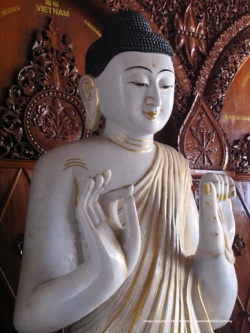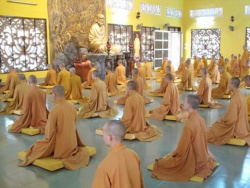Vietnamese Buddhism
Buddhism in Vietnam (called đạo Phật) as practiced by the Vietnamese is mainly of the Mahāyāna school. Buddhism came to Vietnam as early as the 2nd century CE through the North from Central Asia and via Southern routes from India. Vietnamese Buddhism has had a symbiotic relationship with Taoism, Chinese spirituality, and the indigenous Vietnamese religion. The predominant form of Buddhism in Vietnam is a combination of Pure Land and Zen. Zen practice, with its emphasis on meditation is mostly pursued among the monks and nuns, while Pure Land philosophy and practice is preferred by the lay-people. The methods of Pure Land Buddhism are perhaps the most widespread within Vietnam. It is common for practitioners to recite sutras, chants and dharanis. It is a devotional practice where those practicing put their faith into Amitabha Buddha (V. A Di Đà Phật). Followers believe they will gain rebirth in the Pure Land by chanting Amitabha’s name. The Pure Land is where one can more easily gain enlightenment through true faith so end suffering. Many religious organizations have not been recognized by the government however in 2007, with 1.5 million followers, The Vietnamese Pure Land Buddhism Association (Tịnh Độ Cư Sĩ Phật Hội Việt Nam ) received official recognition as an independent and legal religious organization. Today, Buddhists are located almost everywhere in Vietnam (From North to South).
Buddhism is the single largest religion in Vietnam, with over 80% of Vietnamese identifying themselves as Buddhist. the main Buddhist festivals are Vesak (Buddha’s Birthday) and Vulan (Ullambana). Vietnamese traditionally visit the temple on the fifteenth day of the Lunar month (Ram), and also in the various festival days of the Mahayana Buddhas and Bodhisattva s. Committed lay people go through a formal ceremony of “taking refuge”, where they are given a Buddhist name. They wear a traditional grey costume over their normal clothes when they go to the temple, to signify their status as serious Buddhists. Jodo Shin nor its counter Pure Land parts in China or Korea are not the only prevayers of the Pure Land. Many Mahayana Schools of varied nations adapt to Pure Land some times in Combination. Some sects get the notions wrong and treat Amida Buddha and Pure land as a heavenly afterlife. And also practice Astrology, and fortune telling. These items maybe fun yet should not have a place in Buddhism. the history of Buddhism in Vietnam. Buddhism came to Vietnam from India by sea in the first century of the common era, during the time of King Asoka, India’s great Buddhist emperor. They brought, of course, Hinayana Buddhism, today known as Theravada Buddhism. Two hundred years later a Chinese community was well established. From a description of a Chinese convert, who wrote that the monks wore saffron robes, shaved their heads and ate only one meal a day, it is clear that Theravadan monks were serving their community. Thao Duong. This school was a union of Zen and Pure Land. When you begin Pure Land practice, you think of the Buddha and his Pure Land as being apart from you. But as you practice it, slowly you come to realize that you and Amitabha are one and the same. You can experience the Pure Land right here and now. The Pure Land philosophy is embraced through out Asia and each institution studies internationally the varied sect of Pure Land Buddhism.

